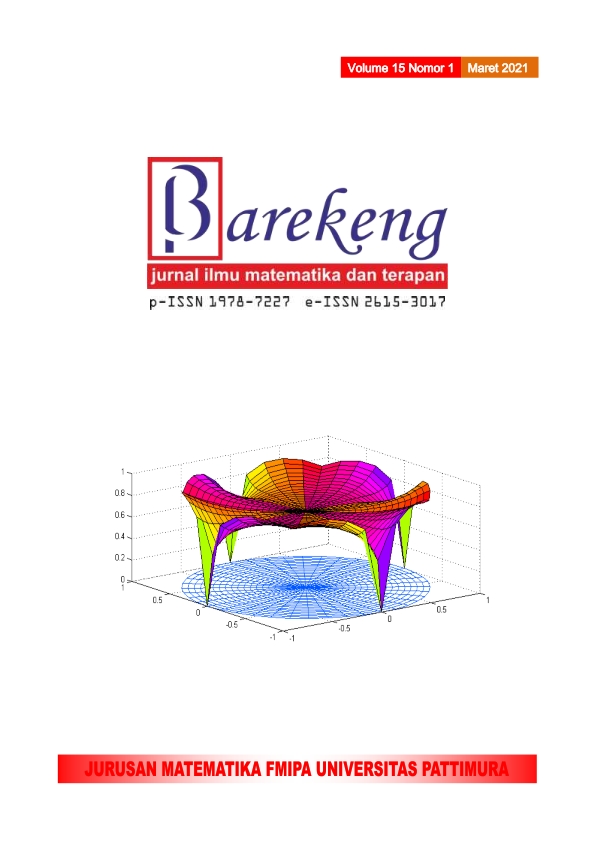PENGENALAN EKSPRESI RAUT WAJAH BERBASIS JARINGAN SARAF TIRUAN BACKPROPAGATION DENGAN METODE PRINCIPAL COMPONENT ANALYSIS
Abstract
The development of artificial neural networks is related to statistical and biometric analysis which is one of the applications that can require artificial neural network models. Recognition of facial patterns is an important part of identifying a person. The face can be divided into areas such as the nose, eyes and mouth. Face pattern recognition is a research area that can be applied to the principal component analysis (PCA) method. The training process carried out by the eigenface calculation uses PCA and the results of this study show that facial pattern recognition based on the proportion of memorization and generalization for the use of the method without PCA is better than facial pattern recognition using PCA. Pattern recognition without using the PCA method, the level of memorization and generalization reaches 100% at the 40th iteration and 0.0099 error with a learning rate and momentum of 0.8, while facial pattern recognition using the PCA method, the memorization and generalization level reaches 100% in the iteration. to -1000 and error 0.00103 with learning rate and momentum 0.9.
Downloads
References
I. Masi, Y. Wu, T. Hassner, and P. Natarajan, “Deep Face Recognition: A Survey,†2019, doi: 10.1109/SIBGRAPI.2018.00067.
I. kholis and A. Rofii, “Analisis Variasi Parameter Backpropagation Artificial Neural Network Pada Sistem Pengenalan Wajah Berbasis Principal Component Analysis,†J. Kaji. Tek. Elektro, vol. 2, no. 1, pp. 1–12, 2017.
Fares Jalled, “Enhanced Reader.pdf,†Nature, vol. 388. pp. 1–14, 2017, [Online]. Available: http://arxiv.org/abs/1705.02782.
S. Kusmaryanto, “Jaringan Saraf Tiruan Backpropagation untuk Pengenalan Wajah Metode Ekstraksi Fitur Berbasis Histogram,†vol. 8, no. 2, pp. 193–198, 2014.
H. Oliveira and P. L. Correia, “CrackIT - An image processing toolbox for crack detection and characterization,†2014, doi: 10.1109/ICIP.2014.7025160.
Y. Elviralita and A. Hidayat, “Identifikasi Pola Iris Menggunakan Metode Backpropagation,†Manutech J. Teknol. Manufaktur, vol. 8, no. 02, pp. 43–48, 2019, doi: 10.33504/manutech.v8i02.21.
W. Liu, Y. Wen, Z. Yu, M. Li, B. Raj, and L. Song, “SphereFace: Deep hypersphere embedding for face recognition,†2017, doi: 10.1109/CVPR.2017.713.
A. Vyas, S. Yu, and J. Paik, “Fundamentals of digital image processing,†in Signals and Communication Technology, 2018.
F. Hermawan, “Implementasi Jaringan Saraf Tiruan Backpropagation Untuk Mengenali Motif Batik,†Ilm. Komput. dan Inform., 2014.
H. Herman, L. Syafie, and D. Indra, “Pengenalan Angka Tulisan Tangan Menggunakan Jaringan Saraf Tiruan,†Ilk. J. Ilm., 2018, doi: 10.33096/ilkom.v10i2.317.201-206.
A. Sinkov, G. Asyaev, A. Mursalimov, and K. Nikolskaya, “Neural networks in data mining,†2016, doi: 10.1109/ICIEAM.2016.7911596.
A. Ghaseminejad and V. Uddameri, “Physics-inspired integrated space-time artificial neural networks for regional groundwater flow modeling,†Hydrol. Earth Syst. Sci., vol. 24, no. 12, pp. 5759–5779, 2020, doi: 10.5194/hess-24-5759-2020.
J. O’Rourke and G. T. Toussaint, “Pattern recognition,†in Handbook of Discrete and Computational Geometry, Third Edition, 2017.
D. Erhan, C. Szegedy, A. Toshev, and D. Anguelov, “Scalable Object Detection Using Deep Neural Networks,†in 2014 IEEE Conference on Computer Vision and Pattern Recognition, Jun. 2014, pp. 2155–2162, doi: 10.1109/CVPR.2014.276.
N. Cintisa et al., “Pengenalan Ekspresi Pada Raut Wajah Pada Keselamatan Berkendara Menggunakan Principal Component Analysis ( Pca ) Dan Linear Discriminant Analysis ( Lda ) Facial Emotion Recognition for Safety Driving Using Principal,†vol. 6, no. 3, pp. 10292–10300, 2019.
V. Lopez-Pastor and F. Marquardt, “Self-learning Machines based on Hamiltonian Echo Backpropagation,†2021, [Online]. Available: http://arxiv.org/abs/2103.04992.
V. S. Doan and D. S. Kim, “DOA estimation of multiple non-coherent and coherent signals using element transposition of covariance matrix,†ICT Express, vol. 6, no. 2, pp. 67–75, 2020, doi: 10.1016/j.icte.2020.03.008.
N. Das and R. Bhattacharya, “Eigen Value Analysis in Lower Bounding Uncertainty of Kalman Filter Estimates†no. January. pp. 104–107, 2020, [Online]. Available: http://arxiv.org/abs/2003.06029.
R. Vahdani, H. Khalegi Bizaki, and M. J. Fall, “New correlated MIMO radar covariance matrix design with low side lobe levels and much lower complexity,†Chinese J. Aeronaut., vol. 34, no. 1, pp. 327–335, 2021, doi: 10.1016/j.cja.2020.08.034.
F. Nebus and S. Gažovová, “The covariance matrix analysis and statistics for near-field sources localization model,†Adv. Mil. Technol., vol. 15, no. 1, pp. 149–162, 2020, doi: 10.3849/aimt.01329.
Å. G. Gajewski, J. ChoÅ‚oniewski, and M. Wilinski, “detected hidden layer.pdf.†2021, [Online]. Available: http://arxiv.org/abs/2101.11758.
N. J. Guliyev and V. E. Ismailov, “Two_Hidden_Neurons.Pdf.†[Online]. Available: Guliyev, Namig J.%0AIsmailov, Vugar E.
Authors who publish with this Journal agree to the following terms:
- Author retain copyright and grant the journal right of first publication with the work simultaneously licensed under a creative commons attribution license that allow others to share the work within an acknowledgement of the work’s authorship and initial publication of this journal.
- Authors are able to enter into separate, additional contractual arrangement for the non-exclusive distribution of the journal’s published version of the work (e.g. acknowledgement of its initial publication in this journal).
- Authors are permitted and encouraged to post their work online (e.g. in institutional repositories or on their websites) prior to and during the submission process, as it can lead to productive exchanges, as well as earlier and greater citation of published works.






1.gif)



